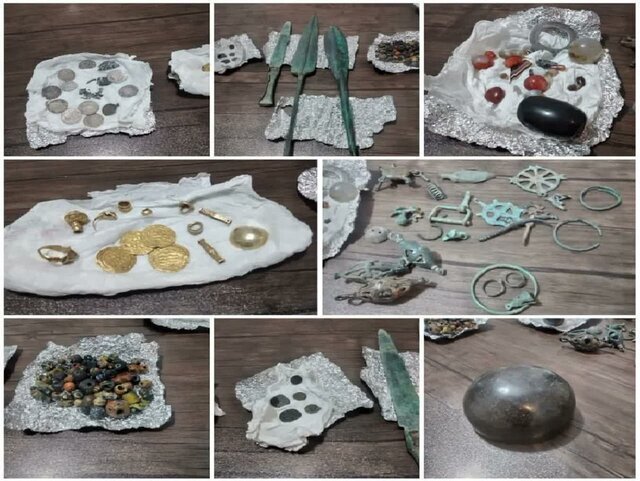298 relics recovered from smuggler's house in northern Iran

TEHRAN — Iranian authorities have recently recovered a haul of historical relics from the home of a smuggler in northern Iran.
Following inconspicuous monitorings and investigations, police forces realized that a number of historical objects were being kept in a house located in Lakan village of Rasht county, ISNA quoted a local police commander as saying on Wednesday.
They finally found and confiscated 298 historical objects after examining the place with judicial coordination, Azizollah Maleki said.
“The discovered objects include 11 silver coins, 4 gold coins, 2 crushed silver coins, 2 gold rings, 10 gold earrings, one gold button, 2 gold necklaces, 2 turquoise gems rings, 2 bronze bowls, one bronze ring, one pottery pendant, 5 copper coins, 3 bayonets, one copper cup, 122 decorative stones, one brass necklace, 102 ornamental beads, 25 metal objects, and one iron bead.”
The relics are estimated to date from various prehistorical times to the Parthian, Sassanid, Islamic, and contemporary eras, the commander said.
In that regard, a 41-year-old individual was detained and surrendered to the judicial system for further investigation and trial, he added.
The consecutive eras of Parthians, Sassanids, and Islamic conquerors are of very high importance in the rich turbulent history of the nation.
The Parthian Empire (247 BC–224 CE), also known as the Arsacid Empire, was a major Iranian political and cultural power in ancient Iran. The Parthians largely adopted the art, architecture, religious beliefs, and royal insignia of their culturally heterogeneous empire, which encompassed Persian, Hellenistic, and regional cultures. At its height, the Parthian Empire stretched from the northern reaches of the Euphrates, in what is now central-eastern Turkey, to eastern Iran. Parthian wealth obtained through lucrative trade networks resulted in substantial patronage of the arts, in particular, relief sculpture, statuary (large and small scale), architectural sculpture, metalwork, jewelry, and ceramics; coins with images of Parthian rulers form another important category of objects.
In about 220 CE, the Sasanian dynasty of Iran introduced the concept of thin flan coins, issues that were struck in relief on both sides. In order not to produce intolerable stresses in the dies, since the thinner the material the more force necessary to make it flow into the recesses of the die’s design, the depth of relief on such coins was of necessity much shallower than with earlier currency. Such techniques spread by way of Byzantium to northern Europe, where the emperor Charlemagne struck thin flan deniers (small silver coins), or pennies, which became characteristic of both his own and neighboring kingdoms.
The Muslim conquest of Persia, also known as the Arab conquest of Iran, led to the fall of the Sasanian Empire of Iran (Persia) in ca. 651 and the eventual decline of the Zoroastrian religion. The rise of Muslims coincided with an unprecedented political, social, economic, and military weakness in Persia. The conquering Muslims at first mimicked the coinage of their predecessors. In the western provinces, they issued gold and copper pieces imitated from contemporary Byzantine coins, modifying the cross on the reverse of the latter somewhat to suit Muslim sensibilities.
AFM
Leave a Comment